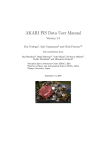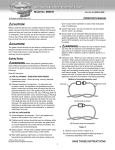Download 20 ESSENTIAL TIPS FOR
Transcript
(-$G8>< =I<< 9FELJ >L@;< %33%.4)!, 4)03 &/2 ,)6 % 34/ #+ " ! 2 . # 2 / 03 + ) 4 # ( % . livestock HOME REMEDIES Feed store fixes Medicine cabinet fixes 2 HOBBY FARMS Kitchen cures PHOTOS BY KAREN K. ACEVEDO K eeping livestock can be an expensive endeavor, but keeping them healthy can be even more costly. Here are some time-tested home remedies that can help your horse, cow, rabbit, goat or sheep in a pinch; all of them can be found easily—and most you already own! RESCUE REMEDY: A few sprays of this stressreducing formula (for humans and animals) into the animal’s mouth will calm it so it can be helped. (www.rescueremedy.com) TEA TREE OIL: The oil is an anti-yeast, antifungal and antibacterial substance that also comes as a cream. OATMEAL: Uncooked oatmeal aids in keeping the digestive system moving, cutting down on the possibility of a blockage and keeping the digestive tract healthy. LIVE-CULTURE YOGURT: Yogurt adds good, live bacteria back into the digestive system. GAS-X: Used to treat bloat problems in ruminants (Pepto Bismol and baking soda also work). PEDIALYTE/GATORADE: Dehydration can accompany diarrhea and needs attention to replenish fluids and rebalance electrolytes. HYDROGEN PEROXIDE: A dosing syringe (minus the needle) filled with hydrogen peroxide works to clean and flush a wound. NUTRI-DRENCH: With vitamins and molasses, Nutri-drench goes straight to the animal’s bloodstream in seconds, raising its blood sugar level. (http://bovidr.com/nutridrench.html) ALOE HEAL CREAM: Aloe promotes healing, allowing a wound to mend quickly from the inside out. (www.farnam.com) MOLASSES: Fill a five-gallon bucket with half molasses and half hot water and sprinkle it on a five-by-five roundbale to enhance rumen function in cows; this allows better absorption of nutrients and increased energy for milk production. DIATOMACEOUS EARTH: The fossilized remains of hard-shelled algae is a quick, easy way to treat animals for worms. PROBIOS: Live microbiotic gel is given orally to help establish and maintain beneficial intestinal bacteria. It stimulates appetite and aids digestion. (www.probios.com) livestock PHOTOS BY JULIE WALKER HAND MILKING 101 Left: Examine the first few squirts of milk for strings, lumps or a watery consistency that might indicate mastitis. Right: When finished milking, dip teats in a fresh antibacterial solution. M any hobby farmers dream big; they want their own goat-milk soap company, their own Grade-A dairy to produce artisan cheeses or even the ability to sell raw milk right off their farm. This all begins with milking! Some farmers may have to milk their animals out of necessity: the loss of a lamb, calf, foal or kid. Whatever the reason, it’s beneficial to have at least a basic working knowledge of how to milk animals. Hand milking is a team effort between you and the animal. When the milker preps his animal by washing her udder, the hypothalamus in her brain signals her posterior pituitary gland to release oxytocin into her bloodstream, causing tiny muscles around those milk-holding alveoli to contract. In other words, she “lets down her milk.” Milk letdown lasts five to eight minutes and milking must be completed during that time. It is imperative to provide a quiet atmosphere for milk letdown; if the animal becomes excited, frightened or experiences pain, her adrenal gland secretes adrenaline, which constricts blood vessels and capillaries in her udder and blocks the flow of oxytocin needed for effective milk letdown. Whatever the species, the same, basic handmilking protocol applies. Let’s imagine you’re milking a goat. You will need: ✓ Squeaky-clean hands with short fingernails ✓ A recently sterilized, seamless, stainless steel milking pail ✓ Udder wash and paper towels ✓ Teat dip and a teat dip cup or a pair of dispos- 3 HOBBY FARMS able, 3-ounce paper cups ✓ A strip cup with a dark, perforated insert ✓ A sturdy milking stand set up against a wall in your milking area with grain waiting in the feed cup STEP 1 Lead the doe to the milking stand, ask her to hop up and secure her head in the stanchion. STEP 2 Wash her udder using your favorite prepping product. Dry each half using a paper towel, then massage her udder for 30 seconds to facilitate milk letdown. STEP 3 Squirt the first few streams of milk from each teat into your strip cup and examine it for strings, lumps or a watery consistency that might indicate mastitis. STEP 4 Place milking pail slightly in front of the goat’s udder, sit down and grasp a teat in each hand. STEP 5 Trap milk in each teat by wrapping your thumb and forefinger around its base. Squeeze with your middle finger, then your ring finger and then your pinky, in one smooth, successive motion to force out milk trapped in the teat cistern into your pail (never, ever pull on her teats). Relax your grip to allow the cistern to refill and do it again. Alternate squeezing one teat while the other refills. STEP 6 Gently bump or massage the goat’s udder to encourage additional milk letdown as the teats deflate and become increasingly more flaccid. Don’t finish by stripping the teats between your thumb and first two fingers; this hurts and annoys the goat. STEP 7 Pour enough teat dip into the teat cup (or paper cups) to dip each teat in fresh solution and allow the teats to air dry. livestock KIM & KARI BAKER ID YOUR STOCK A freeze brand is an effective way to identify your stock. W e’ve all heard horror stories of the cows getting out, horses being stolen, dogs getting lost or sheep playing Houdini. Cut down on the chances of losing your livestock with these identification methods. ✓ FREEZE BRAND: A relatively painless, easy-toread freeze brand is a highly effective method of animal identification. Freeze brands are applied using a cold iron, which destroys the cells in the skin that produce color in the hair. The hair grows back white and in the image of the brand. ✓ HOT BRAND: Once the only type of branding performed on livestock, the hot brand is still used on horses, cattle, sheep, pigs and goats. A hot iron is applied to the animal’s face, neck, shoulder or rump. The heat from the iron kills the hair-producing cells and hair does not grow back in the affected area. ✓ MICROCHIP: Electronic identification microchips have been used by cat and dog owners for some time now, and are becoming more widely used on livestock, including horses, alpacas, cattle, sheep, pigs and goats. A veterinarian injects a tiny computer chip into a ligament at the base of the animal’s neck (injection site varies in food animals). Each chip contains a unique number that corresponds to the owner’s information, which is maintained electronically by a microchipregistering company. ✓ TATTOO: Lip and ear tattoos are another method of livestock identification. Owners who choose to tattoo their horses, cows, sheep, goats or pigs on the ear or inside the lip can use whatever symbols they prefer, although some states—and breed associations—have livestock identification programs with rules regarding tattoos. ✓ TAGS: Cattle, sheep, goats and pigs can also be marked with ear tags or leg tags. Poultry can be tagged on the leg or wing. Made from nylon, plastic or metal, these tags may contain any information you wish, including your phone number, address or other identifying characters. GENETICS FOR BREEDERS D on’t know your genes from your jeans? No problem. Here’s a short vocabulary list to get you started: CHROMOSOME: The rod-like structures within the cell nucleus where genetic information is encoded; consists of DNA molecules coiled around proteins. DNA: The double-stranded molecule in cells that carries genetic information. DOMINANT: This form of a gene always shows itself in the next generation, even if only one copy passes on. GENE: The basic unit of heredity within cells; it consists of a segment of DNA or RNA located along 4 HOBBY FARMS the chromosome. GENETICS: The study of heredity. GENETICIC VARIATION: The difference in the genetic make-up of organisms. GENOTYPE: The genetic constitution of an organism. HEREDITY: The way traits (i.e., coat/feather color or wool-fiber diameter) pass from generation to generation. PHENOTYPE: The physical expression, or visible characteristics, of an organism’s genotype. RECESSIVE: This form of gene only shows itself in the next generation when two copies are passed on. livestock TRAILERS FOR MOVING Compact Goat Gopher O ut here, trailers need to haul everything from cattle, hay and tools to tractors, split wood and produce. Find out which trailer best suits your needs. ✓ SLIDE-IN TOPPERS are small, metal-and-wire cages that slide onto a trailer or in the back of a truck for moving small livestock, like the Alum-Line Popper (at right) or the Goat Gopher, above. These trailers are great for moving smaller livestock when a full-sized trailer is unnecessary. Alum-Line Popper ✓ UTILITY TRAILERS are flat trailers without walls that hitch to the back of the vehicle for hauling equipment and materials. These trailers are the perfect solution for transporting goods that may be to bulky too fit in a covered trailer. They’re much easier to load then the back of a pickup. ✓ STOCK TRAILERS are covered trailers that hitch to the back of the vehicle for hauling livestock and other farm-related cargos. These trailers have an open design with no dividers to separate livestock or cargo. They’re perfect for get5 HOBBY FARMS ting that load of hay in even when it rains! ✓ HORSE TRAILERS are designed specifically for the needs of horses; these covered trailers with dividers can carry horses, tack, hay and more. Horse trailers come in a vast array of styles, from the most simplistic that holds only one horse to large, fancy affairs that must be hauled with a semi and can hold upwards of 12 horses. crops/gardening CROPS TO CONSIDER O ne of the benefits of living off the land is the ability to grow the majority of what you eat. Check out these veggie varieties that can enhance your summer dinner table (These varieties are natural climbers and benefit from trellising): Tomatoes ✓ HONEY GRAPE: Delicious, bite-sized fruit. ✓ SUPER SIOUX: Mid-sized, 4- to 6-ounce fruit produces well until a hard freeze. ✓ RUTGERS: This 5- to 7-ounce tomato is excellent for canning. ✓ BIG BOY: These tasty, crack-resistant tomatoes can reach one pound. ✓ BRANDYWINE: This is a 10- to 16-ounce favorite with lots of flavor. ✓ EARLY GIRL: Popular, early maturing variety with 4- to 5-ounce fruit. Pole Beans ✓ KENTUCKY WONDER: 6- to 8- foot long vines; long-time favorite. ✓ BLACK-SEEDED BLUE LAKE: 6- to 8-foot long vines; stringless and vigorous grower known for excellent flavor. ✓ KENTUCKY BLUE POLE: 6- to 8-foot long vines; a hybrid of Kentucky Wonder and Blue Lake. ✓ SCARLET RUNNER: 8- to 12-foot long vines; crimson-red flowers are edible, as well as the beans themselves. Scarlet Runners are ideal for kids’ forts. Peas ✓ SUGAR SNAP: 4- to 5-foot long vines; longtime favorite of sweet, early peas. 6 HOBBY FARMS ✓ TALL TELEPHONE: Up to 6-foot long vines; great for canning and freezing, as well as eating out of the garden. Melons ✓ MOON AND STARS WATERMELON: Unique looking, 25- to 30-pound watermelon with dark pink flesh. ✓ SUGAR BABY WATERMELON: 6- to 10-pound. fruit. ✓ BLENHEIM ORANGE MUSKMELON: 2-pound melons that mature early. Cucumbers ✓ MARKETMORE 76: 8- to 9-inch slicer. ✓ ARMENIAN: Looks like a cross between a cucumber and a melon; it’s best eaten when it’s around 12 inches long. Squash and Pumpkins ✓ JACK-BE-LITTLE PUMPKIN: More ornamental than edible, but cute as a button. ✓ PATTY PAN SQUASH: The saucer-shaped squash is a prolific producer. ✓ ZUCCHINI JACKPOT HYBRID: Early summer squash starts producing in approximately 50 days. crops/gardening NO-TILL Mulch is the magic bullet in no-till gardening. AMY GRISAK N o-till gardens can help save your back and the soil you plant in. Discover the benefits of farming “the lazy way.” Planning a no-till garden starts like planning a traditional garden. Sketch out a rough map of where crops should go based on the previous years’ location, and devise an estimated planting and harvesting schedule to anticipate the seasonsuccessive planting time frame. Leave enough room in the walkway to kneel between mature plants and to push a wheelbarrow without crushing stems or vines by using 12-inch planting rows bordered by at least a 36-inch walking space, or 30inch rows and 18-inch pathways. This also keeps the planting beds from becoming packed down. Regardless of the method, mulch is the magic bullet in no-till gardening. The pathways are critical, as well. First line them with cardboard or several layers of newspaper, then pile on grass clippings, leaves or old straw. The straw comes apart in flakes, making it easy to layer like golden pavers. If barley or oats sprout from it, they are easy to pull and add back to the garden. Normally, one layer of straw will last the entire season, making a soft, mud-free path that’s easy on the knees. Be sure not to plant the same family of plants in the same area during consecutive years. A three- year rotation is the best bet to minimize potential disease and keep plant-specific insects from knowing exactly where to find the tastiest cabbage, potatoes, tomatoes and other garden favorites. SAVING TOMATO SEEDS L ove the Brandywine, Amish Paste or Oxheart tomatoes you grew this summer? Save money next year by learning how to save your own seeds! It isn’t tough, but it can be a bit messy. STEP 1 Squeeze out the jelly-like substance containing the seeds from the cavity of the ripest tomatoes from the best plants. Add 1⁄4-cup of water, put in a dish and cover loosely. STEP 2 Ferment for three to four days in a warm place, stirring once a day. STEP 3 Pour off liquefied pulp and floating seeds, retaining the seeds that have sunk to the bottom. 7 HOBBY FARMS STEP 4 Place these seeds in a dish and dry for three to seven days. STEP 5 Label and store in a tightly sealed, glass container in a cool place. Heat and moisture are the worst enemies of stored seeds. For a complete seed-saving guide that describes specific techniques for saving the seeds of 160 different vegetables, purchase Seed to Seed, Second Edition, by Suzanne Ashworth. This book can be ordered from Seed Savers Exchange at www.seed savers.org or by calling (563) 3825990. Seed Savers is located in Decorah, Iowa. crops/gardening GRAINS Right: A handoperated grain mill will grind grain into a useable grade of flour. T hink your homemade bread could benefit from an even more hands-on approach? Try growing your own grains! There’s nothing like sowing, harvesting and winnowing your own grains to make delicious, homemade bread and pastries. Wheat, barley, oats and rye should be planted in ground that has been cultivated for at least a year. While full sun is a prerequisite for maximum yields, cereal grains tolerate poor soils, low moisture and cool temperatures. As you till the land, work in as much compost as you can spare and lime if indicated by a soil test kit. Tilling just before planting guarantees a fluffy seedbed in which to broadcast your seeds. A sicklebar mower is the tool of choice for smallgrain harvesting, but you can also use a scythe—a two-handed knife mounted on a long handle (called a “snath”). With a bit of practice, you’ll be swinging it in large arcs parallel to the ground, cutting the stalks at their base and laying them down flat in a neat pile. Gather up a bundle of stalks with the heads facing in the same direction (this is a “sheaf” of grain) and tie them together near the top with a piece of stem. Stick three or more sheaves into the crop stubble, grain toward the sky, and carefully start stacking additional sheaves around them, like a teepee; this is called a shock. When the shock is large enough to wrap your arms around, bind them together and start a new one. At this point, you can bring them inside to continue drying—either hung upside down 8 HOBBY FARMS LEFT: CHARLES CAPALDI, RIGHT: COURTESY LEHMANS Left:Homemad e bread made with homegrown grains can’t be beat! from the rafters or shocked on the barn floor. No matter how you harvest, the grain needs to be separated from the layer of bran and husk that protect it. Lay out the sheaves on a large tarp and pound them with a flail—a foot-long piece of wood attached to a handle by a leather thong. The stalks (technically “straw”) can be used for livestock bedding or mulch. The grain is collected for winnowing, something best done on a windy day or in front of a strong fan. Put the grain and the loose hulls (or chaff) that surround it into a shallow basket. Flip the basket up so the grain is airborne and catch it as it falls. The lighter chaff will be carried away by the breeze, leaving the winnowed grain behind. The winnowed grain can be scooped into burlap bags. Make sure that it has dried down to 10 to 15 percent moisture before storing; grain that isn’t dry enough will mold. crops/gardening TOOLS: WEED CONTROL Rocket Weeder Echo C.A.R.B. SRM-210i Weed Dragon W eeding may not be the most exciting summertime chore, but it’s one that can quickly get out of hand if neglected. Reclaim your garden with these helpful tools. ✓ ORGANIC MULCH helps stop erosion, halts weed growth, moderates soil temperature and moisture, keeps fruits and vegetables clean, and nourishes the soil as it decomposes. Organic mulches include straw or weed-free hay; wood chips; and shredded bark, leaves or newspaper. Be sure you know where your mulch comes from so you don’t accidentally sow your fields with weeds! ✓ STRING TRIMMERS are a quick, temporary fix that cut weeds off at ground level. Trimmers come with two- and four-cycle engines. Twocycle engines burn a mix of gasoline and oil; four-cycle engines run on gasoline. ✓ MANUAL WEEDERS are a low-tech mode of weeding that use tools ranging from the most basic hoes to combination models that cultivate, rake, pull and dig. ✓ ORGANIC HERBICIDES kill or inhibit the growth of weeds safely and effectively. Most organic herbicides require at least two applications. ✓ FLAME WEEDERS are an easy and effective way to remove weeds on a large scale. Flame weeding destroys the plant’s cell structure. ✓ NATURAL WEEDERS are specific breeds of livestock, such as particular breeds of sheep, geese or goats, that prefer to browse on tough weeds. All three species require company (multiple animals), adequate fencing, predator protection, shelter, water and supplementary feed. HOT OFF THE P R E S S E S ! Check out the newest titles from our Popular Farming Series: Organic Farm and Heirloom Farm. You can order them by calling (800) PET-BOOK or by logging on to www.shopanimalnetwork.com Get your copy today! 9 HOBBY FARMS home/barn SOAP Homemade soap is not difficult to make, but steps must be followed precisely. H omemade soap is not difficult to make and is a delightful treat for birthdays, holidays or those special overnight guests. Make some today! Select a mold that’s large enough for approximately 8 pounds of soap and line it. Set on newspaper. Put on safety glasses and rubber gloves. Measure 12 ounces of lye into the 2-cup measuring cup. Measure cold water into the 4-quart steel pot. Slowly stir lye into the water. Use caution—the lye will heat the water to boiling and cause fumes for a few minutes. This is your lye/water solution. Set it aside to cool down to 95 degrees F. Now add the oils into your soap kettle and slowly heat to 100 degrees F. Once the correct temperatures have been reached for both the lye/water solution and the oils, it’s time to blend them together. Pour the lye/water solution into the melted oils. Stir slowly, steadily and constantly with a stainless steel or wooden spoon. The mixture will need to be stirred for 25 to 45 minutes or more. Do not leave unattended. As the liquid begins to saponify, you’ll witness the true magic of soapmaking. Pay attention Country Oatmeal Soap ■ 2-cup measuring cup ■ 4-quart steel pot GUSTAV STUDIO ■ 2 large, stainless steel or wooden INGREDIENTS: ■ 32 oz. coconut oil ■ 16 oz. palm oil ■ 17 oz. virgin olive oil ■ 12 oz. almond oil ■ 8 oz. caster oil ■ 32 oz. soft water ■ 12 oz. sodium hydroxide (lye) ■ 1⁄3 cup ground oatmeal ■ 2 tsp cinnamon ■ 3 T. cinnamon essential oil or fragrance ■ 1 T. orange oil or fragrance TOOLS: ■ 12-quart stainless steel pot (soap kettle) 10 HOBBY FARMS ■ ■ ■ ■ ■ ■ ■ ■ ■ ■ ■ ■ ■ ■ spoons 2 large, flexible spatulas Whisk Measuring cups Measuring spoons Soap mold, lined Mold liner, plastic or bakery paper Cutting tool Safety glasses Waterproof latex or rubber gloves Digital scale Candy thermometer Blender Paper towels Lined trash can to the consistency of the liquid; it will start to thicken as the oils and the lye/water solution bind together. Eventually it will resemble thin pudding. Once it does, it will have achieved the “trace” stage. This is when you can drizzle spoon contents onto the surface of the liquid mass and see the trace of it on the surface. The mixture will not completely drop off the mixing spoon. Separate approximately one-third of the mixture into the pot used for the lye/water solution, add the cinnamon and fragrance to it and mix well. Pour the uncolored soap mixture into the mold, then slowly pour the colored mixture into the uncolored soap, swirling it in a thin stream. Do not mix or stir. This will create a beautiful marbling effect throughout the bars. Once the soap is poured into the mold, cover the mold and allow the soap to finish saponifying for at least 24 hours. When the soap is 24 to 36 hours old, it will be time to remove it from the mold and cut it into bars. Do not wait—this is best done as early as possible. Ideally, cutting the soap should feel like cutting fresh fudge—fairly easy to slice. If you made soap in a block, decide in advance how you want to measure the bars. The tool you use to cut the soap should slice through the entire length or width to prevent cracking. Position your cutting tool and slice straight down in one cut. Stack the bars to cure for at least six weeks in a dry area. home/barn SAVE TIME AND MONEY TIP #2: Mulch your garden to control weeds, pro- T ime and money seem to always be in short supply on a farm. Check out some tips guaranteed to save you both! TIP #1: Recycle and re-use old, potentially useful items. Mulch your garden to cut down on weeding and watering ime. vide nutrients to plants and retain soil moisture. TIP #3: Buy the best tools you can afford so they’ll last a long time. TIP #4: Install the optimal feeder for your animals. TIP #5: Research and invest in cement or other substrate for the barn floor. TIP #6: Feed your animals quality hay. TIP #7: Buy in bulk and store feed properly. TIP #8: Install fencing that’s sturdy and durable. TIP #9: Practice prevention with regular deworming, hoof trimming, vaccinating and veterinary care. Keep living and eating areas sanitary: Lining the stalls with rubber mats makes for easy cleaning, keeps horses off the mud and prevents them from ingesting unhealthy quantities of sand. TIP #10: Use rotational grazing systems. TIP #11: Choose self-sustaining breeds and plants. TIP #12: When building farm structures from scratch, think through your goals before you start and plan ahead. TIP #13: Design facilities for ease of use. TIP #14: Find and learn from a good breeder. TIP #15: Purchase a guardian animal to protect livestock. BARN EVACUATION CHECKLIST KAREN K. ACEVEDO T he reasons for evacuation can vary throughout the country: fires, mudslides, flooding and even severe winter weather can all be reasons for you to have to leave in a hurry. If disaster threatens, be prepared to evacuate animals at a moment’s notice: ✓ Keep a contact list for your network of helpers beside the phone ✓ Keep pets crate-trained and larger animals schooled on loading into trailers or trucks ✓ Have a “go-bag” ready for pets, including food and water containers, as well as special food or medications 11 HOBBY FARMS ✓ Bring small pets indoors ✓ Have identification and contact information on each collar or halter ✓ Mark stalls or pens—both front and rear exits—with a splotch of paint or colored ribbon to designate priority animals ✓ Train your animals to leave through all exits of stalls or pastures ✓ Keep gas tanks full and vehicles pointed toward the road ✓ Keep trailers hitched and close to stable or loading pens ✓ Decide what to do if any animal balks home/barn FIRST AID KIT U nfortunately, accidents are a part of life on a farm, whether they be relatively minor (Bessie twisted her ankle running in for evening feed) or pretty major (Lassie got a bit too close to a porcupine and the quills are in deep). Having a comprehensive first-aid kit on hand can save precious time when tending a sick animal and can help save money on non-essential vet calls. Here are some basic staples to keep in your kit that are applicable no matter what livestock you keep: ❑ Small, digital rectal thermometer ❑ Veterinary lubricant ❑ Halter and lead ropes or other appropriate restraint devices ❑ Hobbles and/or twitch (for horses) ❑ Premoistened towelettes ❑ Cotton roll ❑ Sterile saline solution ❑ Isopropyl alcohol ❑ Novalsan disinfectant ❑ Two empty (generic) spray bottles ❑ Fly spray repellent/wound treatment ❑ Nutritional and/or anti-scour drench in pump bottle ❑ Disposable syringes in 3, 6, 12 and 60 ccs 12 HOBBY FARMS ❑ Six, 1⁄2” x 18 gauge sterile, disposable needles ❑ Six, 3⁄4” x 18 gauge sterile, disposable needles ❑ Two, 3⁄4” x 16 gauge sterile, disposable needles ❑ Intravenous (IV) unit ❑ Gauze rolls ❑ One package sterile gauze pads ❑ Two, 2” gauze bandages ❑ Two rolls of elastic tape ❑ Dose syringe ❑ Balling gun and/or pill forceps ❑ Dehorning tools (if applicable) ❑ Electrolytes for newborns ❑ Milk replacer for orphaned newborns ❑ Bottle(s) and appropriate nipples for milk replacer ❑ Antibiotic ointment or salve ❑ Optical antibacterial ointment or dust ❑ Blood stopper (i.e., hemodust) ❑ Mineral oil ❑ One propylene glycol ❑ Udder infusion antibiotic ❑ Two or more pairs of disposable, sterile surgical gloves ❑ One pair of stainless steel, veterinary surgical scissors ❑ One each of veterinary forceps and hemostat ❑ Injectable antibiotics ❑ Topical antibiotics (aerosol) ❑ Obstetrical pullers ❑ Stomach tubes ❑ Bloat medicine ❑ Hoof trimming shears ❑ Hoof knife and hoof pick (for horses) ❑ Hair and/or wool trimming shears (electrical and/or manual) ❑ Adequate supply of obstetrical gloves for the birthing season ❑ Tincture of iodine (7%) ❑ Iodine spray (1%) ❑ Heat lamp (for lambs, goat kids and piglets) ❑ Notebook and ballpoint pen home/barn TOOLS: WELDERS Hobart Stickmate LX 235 T hings tend to break around the farm. Knowing how to weld and having the proper tools are essential in getting your equipment up and running, preventing your cows from wandering to the next field or fixing that trailer for the next load of hay. Check out this list of welders to find one right for your farm and skill level. GAS WELDERS use the combustion of acetylene with oxygen to produce flame temperatures of 4,000 to 6,000 degrees F. Level: Beginner to expert Benefits: versatile, portable, inexpensive and easy learning curve Acetylene Tag-A-Long Kit Features: welding and cutting tips, regulators, oxygen and acetylene cylinders, hose, check valves cylinder wrench, safety goggles and operation manual (www.hobartwelders.com) STICK WELDERS use an electric current to strike an arc between the material being welded and a consumable, flux-covered, steel electrode rod that, as it melts, becomes filler material. Level: Beginner Benefits: versatile, portable, inexpensive equip- ment and easy learning curve Lincoln Electric’s AC-225 AC Stick Welder Kit Features: electrodes, welding helmet and Welder’s Guide (www.lincolnelectric.com) STICK/TIG WELDERS have a stick welder with tungsten inert gas capability that uses a nonconsumable electrode made of tungsten, a gas mixture and a separate filler material. Level: Expert Benefits: lightweight, portable, high-quality welds, works well with thin materials TIGMATE Kit Features: electrode holder, gas regulator, amperage control, flow meter, shielding gas hose and “How-To” DVD (www.hobartwelders.com) MIG/FLUX-CORE WELDERS use wire continually fed through a welding gun from a spool or drum as an electrode to complete the electrical circuit and an inert or semi-inert gas mixture to shield welds from contamination. Most MIG welders also feature flux-core welding capabilities. Level: Beginner to expert Benefits: faster welding speeds, greater metal penetration Hobart’s Handler 125 EZ Kit Features: welder, welding gun and tips, work cables, spool shaft and sample wire, power cord and user’s manual. Hobby Farms has a sibling If you’re interested in farmhouse activities like knitting, candlemaking, cooking, decorating and more, check out Hobby Farm Home! Look for the current issue on newsstands or buy a copy at www.hobbyfarms.com www.hobbyfarms.com 13 HOBBY FARMS food/kitchen HOW TO MAKE YOGURT H Heat the milk to 185 degrees F, then let it cool to about 115 degrees F. Put the fresh yogurt culture in the bowl and slowly add the warm milk to it. The temperature of the combined ingredients needs to be about 110 degrees. Once all of the milk has been added, stir gently with a clean, wooden spoon. Next, ladle the warm, cultured milk into either a gallon glass jar with a rim and lid or several smaller canning jars with rims and lids. Place the jar or jars in the appropriate-sized cooler and fill the cooler with warm (about 120 ADRIANNE L. SHTOP ave extra milk on your farm and don’t know what to do with it? Try making homemade yogurt! The possibilities of tasty additions are endless: Make some today! Yogurt is created from bacterial fermentation of the milk sugar called lactose. The process releases lactic acid that thickens the milk, gives it a sour taste and hinders the growth of bad organisms. To make your own yogurt, you’ll need: ✓ A food thermometer marking temperatures of 0 to 200 degrees F ✓ 1 cup of plain, fresh, pasteurized commercial yogurt with “active” bacterial cultures or one freezedried packet of yogurt culture ✓ 1 gallon of milk ✓ An insulated cooler ✓ A sterilized, 1-gallon glass jar or several smaller sterilized canning jars with rims and lids ✓ A large glass or ceramic bowl ✓ A wooden spoon degrees F) tap water. Since the cooler itself is cool, the temperature will drop to about 110 to 112 degrees F. Close the lid and set the cooler aside. Let the bacteria do its thing for the next 10 to 16 hours. The warm water-bath method has worked consistently. Other options are to keep the cultured milk warm with a light in the oven or on a heating pad. When the mixture has thickened, remove the jars from the cooler and pop them into the refrigerator. Be sure to pull a cupful of the yogurt to start your next batch. DRINK NIGHT: BEE’S KISS I t’s a fair bet that any drink with the name “bee” in the title is bound to incorporate a drizzle of honey. In the case of this pre-Prohibition cocktail, the name has a flirtatious meaning as well: A “bee’s kiss” was the term for the fluttering of the eyelashes against the cheeks, lips or nose of one’s beloved. Ingredients: ✓ 2 oz. gold rum (or two-thirds gold and onethird dark rum) ✓ 1 oz. cream 14 HOBBY FARMS ✓ 2 tsp. honey Place ingredients in a cocktail shaker with cracked ice. Shake and strain into a chilled cocktail glass. If desired, dust with a sprinkle of ginger or nutmeg. For your further drinking pleasure, replace the cream with the juice of one lime, omit the sprinkle of spice and you have a delightful cocktail called Air Mail. Recipe reprinted from Cocktail Hour, by Susan Waggoner, published by Stewart, Tabori & Chang. food/kitchen FIGHT ALLERGIES WITH HONEY B eekeepers are finding that there is more to making honey than simply keeping bees. Honey tastes differently from one state to the next, from one county to the next and even from one farm to the next. Each batch is a little different, as the bees frequent diverse flowers, plants and trees in various areas and can fly up to three miles from the hive. The nectar source, as well as the time of year in which the honey was harvested, affects the taste and color of the honey. Like wine, honey is a product of the land. Depending on what the bees have dined on, honey can have a floral undertone; it can also be spicy or even bitter. Raw honey is gaining in popularity as an allergy antidote. Raw honey has not been filtered to remove wax remnants or pollen, nor has it been heat-treated to prolong shelf life. With the same taste, but a different consistency, raw honey is said to be more nutritious and higher in enzymes than filtered honey. Alternativemedicine fanciers recommend a teaspoonful of raw, unfiltered, local honey daily to abate seasonal allergies. The trace amounts of pollen in the honey are said to help develop immunity in the allergy-sufferer, but honey must contain local pollens to be effective. HERBAL VINEGAR A ny herbs can be used to create herbal vinegar and, used in combination with any of the sundry vinegars available at the market, can give a unique boost to salad dressings and marinades. They can be used in any recipe that calls for vinegar. The most commonly used base vinegars for herbal concoctions are cider and red wine—both good choices for strongly flavored herbs like basil or thyme—or white wine, which is good for herbs with a more subtle taste, such as lemon balm. Champagne vinegar is also a good choice for delicate flavors. White distilled vinegar is harsher than the others, so it might not give the best results. The key is to experiment and find combinations you like. For gift-giving, look for decorative jars with tight-fitting, non-metallic stoppers such as the Weck canning jars. (www.weckcanning.com) It takes about one cup of fresh herb leaves, 15 HOBBY FARMS picked just before the plant flowers, or 1⁄2-cup of dried leaves to flavor one quart of vinegar. Use a large, clean, glass jar with a tight-fitting, non-rusting lid. Place herbs in jar and crush slightly with a wooden spoon. In a pan, warm the vinegar, but do not boil. Pour over herbs and cover tightly. Set the mixture in a dark place and let soak for two to three weeks. Strain through cheesecloth into airtight containers. Insert a large fresh leaf of the herb into the container before closing. Store at room temperature. These herbal vinegars are great Christmas or hostess gifts! food/kitchen FOOD PROCESSING EQUIPMENT Ball Home Canning Kit C anning, drying, grinding and juicing are a few of the options available to help harness your gardens harvest. Canners Water-bath Canners and complete kits include a water-bath canner with a wire canning rack, six pint-sized Mason jars with gingham-print lids and rings, a bubble-freer spatula, jar funnel, lid wand and jar lifter. Pressure Canners should feature a rack for jars, a lid that can be clamped or locked down to make the cooker steam-tight, a gauge that accurately registers internal steam pressure, at least one vent port and a gasket to prevent steam leakage. Nesco Snackmaster Express Juicers Centrifugal Juicers feature a bottom-mounted shredder disk and a strainer basket with straight sides. Produce is fed into the top of the machine and pressed through a chute, where it contacts the shredding disk. Juice is released as part of the shredding process and flows out the front of the juicer while pulp remains inside. Masticating Juicers first grate, then chew the pulp to further break down its cell-wall structure. They then press the pulp to extract its juice. Most masticating juicers process even leafy vegetables with ease. Country Living Grain Mill Grain Mills Food Dehydrators Most dehydrators belong to one of two types: rigid boxes with removable trays or units composed of stackable trays. Features to look for include: ✓ Metal or high-grade plastic, double-wall construction ✓ Enclosed heating elements ✓ An enclosed 85 to 160 degree F thermostat ✓ A fan or blower ✓ Four to 10 open-mesh trays made of sturdy, lightweight plastic ✓ A dial for regulating temperature ✓ A timer ✓ The UL seal of approval 16 HOBBY FARMS Stone Mills grind a bit finer than burr grinders, but they’re harder to turn by hand and gum up when used to process oilbearing seeds. Burr Mills are easier to operate because they use steel burrs instead of old-fashioned grinding stones. They are also seed-friendly and more versatile. Cider Presses A hardwood, single-tub cider and wine press is capable of grinding and efficiently squeezing apples, grapes, fruits and vegetables. HF





































